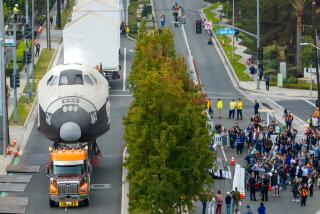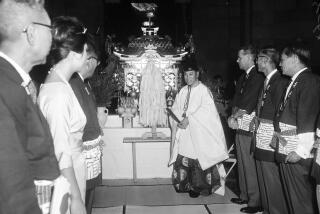Shuttle Endeavour’s final journey is carefully choreographed
- Share via
A diva requires special handling and an entourage. Whatever the stage, the space shuttle Endeavour gets both.
A constellation of engineers and assembly line workers designed and built the shuttle in Southern California. A universe of scientists hurled it into space on 25 missions.
And in the coming weeks, after Endeavour is flown from the Kennedy Space Center in Florida to Los Angeles, a cast of hundreds of engineers, police officers and utility and construction workers will ferry the shuttle over city streets to the California Science Center, where it will be permanently displayed.
PHOTOS: Getting Endeavor ready
Endeavour’s Sept. 20 arrival at Los Angeles International Airport atop a modified 747 airliner — and the spectacle of its ultra-slow-motion, 12-mile crawl through Inglewood and Los Angeles to the science center in October — are expected to draw huge crowds and become a cultural meme for a region defined by its epic commutes.
It’s a homecoming for Endeavour. The nation’s shuttle fleet was built and maintained in Downey, Canoga Park and Palmdale by the region’s once-titanic aerospace industry — Rockwell International, Boeing Co., Lockheed Martin Corp. and Rocketdyne. Edwards Air Force Base was the shuttle’s second home and alternate landing site if bad weather ruled out landing in Florida.
Endeavour’s move to Los Angeles marks an end to NASA’s space shuttle program, which flew its final flight last year after three decades. The three other shuttles are already in their permanent resting places: Enterprise was delivered to a New York City museum by barge up the Hudson River, Discovery was flown to a Smithsonian annex at Dulles International Airport in Virginia, and Atlantis will be displayed at the Kennedy Space Center.
Moving Endeavour through the streets of L.A. presents a logistical challenge worthy of the most technologically complex vehicle ever built.
“It’s not a once-in-a lifetime event. It’s a once event,” said Marty Fabrick, who is managing the move for the science center. “No one is ever going to move a space shuttle through the middle of a congested urban area ever again.”
GRAPHIC: Endeavor’s final journey
Moving Endeavour isn’t like transporting a house on a flatbed truck. It’s more like hauling a five-story apartment building across L.A. — a unique job that will cost the science center millions of dollars.
In the predawn dark of Oct. 12, the Endeavour will creep out of LAX on top of a specialized vehicle typically used in massive construction projects. The self-propelled modular transporter is a 160-wheel beast with the precision of a ballerina. It’s able to carry 15,000 tons and turn 360 degrees in its own footprint. Such transporters are typically used to move bridges, ships and oil drilling platforms.
The 170,000-pound Endeavour will give it a light workout.
Endeavour will make its way along Manchester Avenue and Crenshaw and Martin Luther King boulevards. Maximum speed: 2 mph. It will journey through tidy residential neighborhoods and past schools, churches and sun-baked apartments that look as though they haven’t been painted since the Apollo program.
Endeavour has circled the globe at more than 17,000 mph. But it has never inched past the giant pastry on top of Randy’s Donuts on Manchester Avenue near the 405 Freeway.
“It’ll be a lot of fun,” said Larry Weintraub, 71, who has been slinging doughnuts at his iconic shop for 34 years. “I’m sure all the merchants in the area are hoping the people who come down to see it trickle into their stores.”
Weintraub said that to celebrate, Randy’s “might try something like a space shuttle doughnut.”
Planning has been going on for nearly a year. Multiple routes from LAX to the science center were considered. But the list quickly narrowed because, at 57 feet tall and with a 78-foot wingspan, Endeavour can’t go under the 405. It has to go over.
The urban canopy was mapped in detail — every tree, utility line, traffic signal, light pole and street sign. Where underground utilities run close to the street surface, steel plates will be placed to protect them.
In recent weeks, crews have removed about 400 trees in Endeavour’s path and trimmed many others. Removed trees will be replaced 2 for 1 by the science center out of $200 million it is raising from private sources to move the shuttle to L.A., display it temporarily and build a permanent exhibit space.
As Endeavour ambles along, city workers and crews from Southern California Edison, the Los Angeles Department of Water and Power and a dozen private companies will remove man-made obstructions.
As Endeavour passes, a rear guard of workers will reassemble it all.
“The public is going to have a great opportunity to view this all along the route,” said Lt. Andy Neiman of the Los Angeles Police Department. “They’re going to be able to get pretty close — a half a block or less in places. We want to make this a celebration, a parade atmosphere. But with a lot of heavy security.”
Rolling street closures should keep traffic snarls to a minimum, Neiman said.
It all sounds reminiscent of the move in March of a giant boulder from a Riverside County quarry to the Los Angeles County Museum of Art, where it’s part of an abstract art installation. But that’s where any comparisons end.
One is a rock. The other cost nearly $2 billion.
“Something I learned is how surprisingly fragile the shuttle is if you ask it to do something it wasn’t designed to do,” said the science center’s Fabrick. Workers have been instructed not to touch it. “It’s not good for the vehicle, and we know that,” he said. “It’s a national treasure, and we’re going to treat it with great care.”
Fabrick, 63, spent his career with Pasadena-based Parsons Corp., an international engineering and construction firm which specializes in massive, one-of-a-kind projects such as shipping ports, nuclear power plants, rocket launch systems and airports.
When the science center acquired Endeavour, Fabrick was asked to oversee its move. He leaped at the chance and took early retirement from Parsons.
Fabrick has driven Endeavour’s route more than a hundred times. “From the time I wake up in the morning and step into the shower I’m thinking about it,” he said. “It’s been all consuming.”
Bill Roberts has had the shuttle on his mind for most of his life.
The 56-year-old Boeing engineer began working on the shuttle program straight out of college in 1982. He worked his way up to project manager. After the shuttle Columbia broke apart during reentry in 2003, Roberts led a team that brought the fleet up to new safety standards that cleared the orbiters for flight again.
Not long after that, he was asked to do one final job: develop a plan to retire the fleet. It was a bittersweet assignment given that the orbiters were designed to fly more than 100 missions each. The entire fleet flew 135.
“When I was first approached, my reaction was ‘I can’t believe you’re doing this. There’s so much life left in these,’ ” Roberts said. “Eventually, it was like ‘Oh, get over it. Let’s get on with this and do it the right way.’”
Each shuttle contains more than 2.5 million parts, many of them hazardous. Before Endeavour could be moved to the science center it first had to be stripped of its “hypers” and “pyros” — shorthand for the shuttle’s highly toxic and combustible hypergolic fuel system and the numerous explosive devices used to open hatches and landing gear doors, among other tasks.
It took five years to research and write this final chapter of the storied shuttle. The impenetrable-to-laymen tome is called the “End State Subsystem Safing Requirements Document.”
It’s a title that speaks to the complexity of handling the shuttle, whether it’s traveling 122,883,151 miles through space or merely 12 miles across town.
PHOTOS: Getting Endeavor ready
GRAPHIC: Endeavor’s final journey
More to Read
Sign up for Essential California
The most important California stories and recommendations in your inbox every morning.
You may occasionally receive promotional content from the Los Angeles Times.










